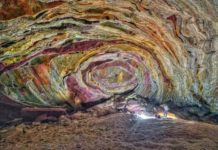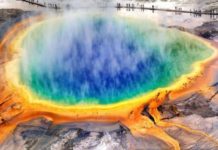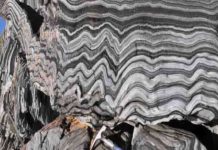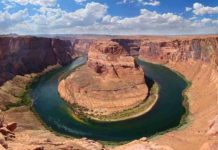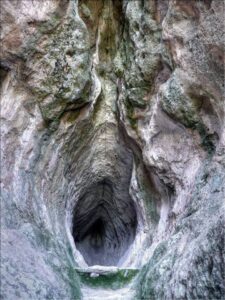
Utroba Cave, located in Bulgaria’s gorgeous Rhodope Mountains, is a natural marvel that draws both explorers and scientists. This underground labyrinth, with its complex structures and timeless beauty, provides insight into the region’s geological past and the forces that formed it over millions of years.
The cave is located 20 kilometers from the city of Kardzhali near the village of Ilinitsa and it dates to 480 BC. It is also referred to as “The Cave Womb” or “Womb Cave” because the entrance is the shape of a vulva. The inside of the cave resembles a uterus. Locally it is also called “The Blaring Rock”.
The Origins of Utroba Cave
Utroba Cave, also known as “The Womb” in Bulgarian, is the result of a gradual yet constant dance between rock and water. The cave, formed in the core of limestone, began its journey aeons ago, when ancient oceans flooded most of what is now Bulgaria. As water percolated through the porous rock, it dissolved the limestone, forming enormous caverns under the surface.
A Geological Tapestry
Utroba Cave’s walls, a geological tapestry spanning millennia, tell its tale. The cave’s formations—stalactites, stalagmites, columns, and flowstones—are the result of water and time. Each drop of mineral-rich water leaves a small deposit of calcite, eventually forming these beautiful formations over thousands of years.
Time’s Impression
To really understand Utroba Cave, consider the massive periods required in its development. Stalactites, which dangle like icicles from the ceiling, develop at a pace of millimetres each century, whereas stalagmites rise almost imperceptibly from the cave floor. Together, they see nature’s slow, patient work, which unfolds across epochs too vast for the human intellect to completely comprehend.
Geological Processes in Play
The development of Utroba Cave demonstrates the complicated interaction of geological processes. It starts with the dissolving of limestone, also known as karstification, in which carbonic acid in rainfall combines with calcium carbonate in the rock, eventually eroding it away. Over time, this results in networks of underground corridors and chambers, such as those discovered in Utroba Cave.
The Role of Water
Water is the major sculptor in caverns like Utroba, forming the scenery both above and below earth. As it seeps through cracks and fissures in the rock, it dissolves the limestone, expanding existing passageways and generating new ones. Underground rivers and streams continue to carve out the cave system, transporting sediments and sculpting the formations we see today.
Geological Time in Perspective
Understanding the immensity of geological time requires confronting the humbling fact of our own fleeting existence. Utroba Cave has evolved over millions of years, long before people roamed the world. It demonstrates the persistent force of natural processes, which are still shaping our globe in subtle and deep ways.
Conclusion
Utroba Cave is a testament to nature’s everlasting beauty and the unstoppable march of geological time. Its structures, formed over millions of years, provide a glimpse into the Rhodope Mountains’ distant history and the forces that shaped it. As we explore the depths of Utroba Cave, let us marvel at nature’s grandeur and consider our role in the great fabric of time.


